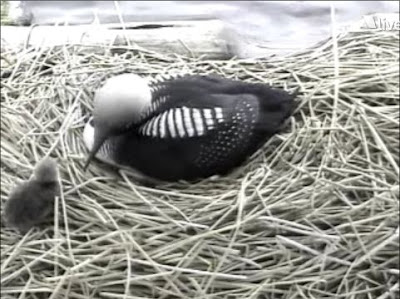
This loon nest is in Anchorage, Alaska, on a small lake right next to the Anchorage International Airport (map). Each year for the past nine years, cam host Jean Tam has broadcast the nesting season of these gorgeous birds—using an artificial nesting island to make the camera set-up possible (see "About the Artificial Island" below). The constant stream of airplanes overhead doesn’t seem to bother them, nor does the adjacent highway or the off-leash dog park surrounding the lake—truly these are “urban” loons.
Pacific Loons are thought to be monogamous within a breeding season and may remain paired in subsequent years as well. The same female has used this island since 2003, when she was banded (look for her bands: blue over white on the left leg; a metal band on the right). Jean suspects that several unbanded males have been her mates in different years based on differences in behavior. Both sexes share incubation. Males and females look similar, but the female is slightly smaller and each year’s male has seemed to be much more alert on the nest than the female.
 The nestlings will remain in the nest until both eggs hatch and the nestlings are dry, at which point they will be brooded on the nest for about a week before they depart. Over the next seven weeks or so, the loon chicks follow their parents around the lake learning to swim and forage before fledging.
The nestlings will remain in the nest until both eggs hatch and the nestlings are dry, at which point they will be brooded on the nest for about a week before they depart. Over the next seven weeks or so, the loon chicks follow their parents around the lake learning to swim and forage before fledging.Pipped 2nd Loon egg 6/13/12
http://www.allaboutbirds.org/page.aspx?pid=2454

